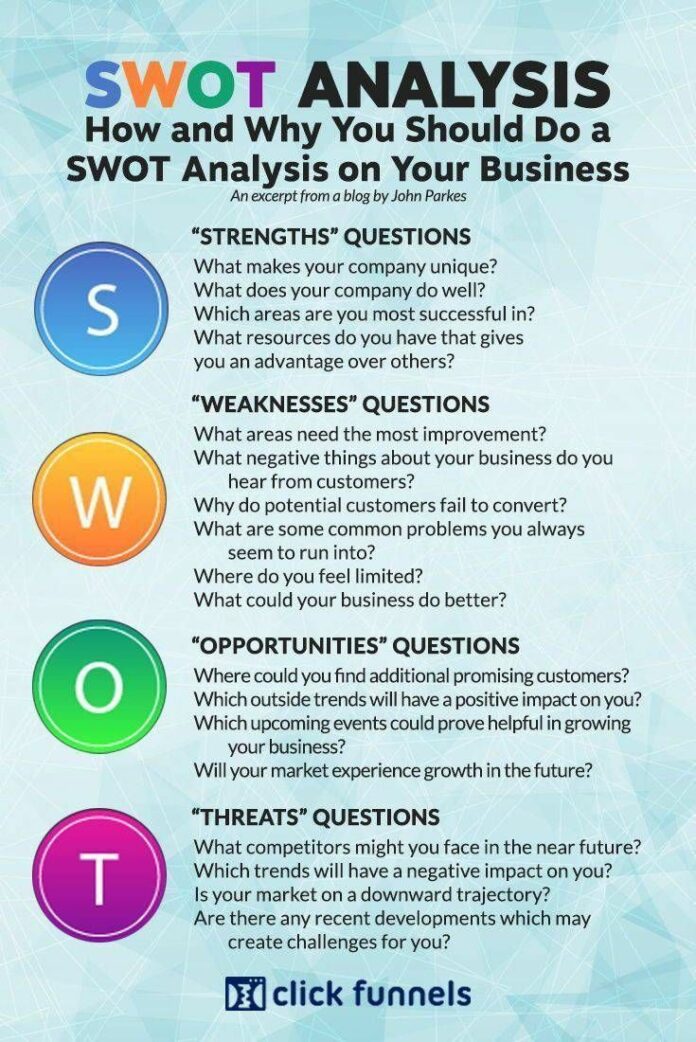A Useful Guide to SWOT Analysis PDF
History of SWOT Analysis
In the 1960s and ’70s, Albert Humphrey is said to have developed this strategic planning tool using data from the top companies in America at the time. A SWOT Analysis looks at the strengths, weaknesses, opportunities, and threats that are relevant to an organization in a new venture.
A SWOT Analysis is a tool that allows users to look at the direction a company or organization may wish to move towards in the future. A SWOT Analysis is a useful tool, which in conjunction with others can help make informed decisions.
Definition of swot analysis in business
By specifying clear objectives and identifying internal and external factors that are either helpful or not, a short and simple SWOT analysis is a useful resource that may be incorporated into an organization’s strategic planning model.
- Strengths: Internal attributes that are helpful to the organization in achieving its objective
- Weaknesses: Internal attributes that are harmful to the organization in achieving its objective.
- Opportunities: External factors that help the organization achieve its objective
- Threats: External factors that are harmful to the organization in achieving its objective.
After identifying the SWOTs, identification of the factors and their interdependence helps clarify the steps needed to achieve the ending objectives.
Potential Uses of SWOT Analysis
SWOT analysis has been used at different levels of analysis in many arenas, not just in profit-seeking organizations. Examples include non-profit organizations, governmental units, and individuals. SWOT analysis may also be used in pre-crisis planning and preventive crisis management.
SWOT analysis may also be used in creating a recommendation during a viability study/survey. Subscription databases that are available in many libraries, such as Business Source Elite and Gale Business Insights, regularly produce new SWOT analyses of companies.
- Set Objectives– defining what the organization is intending to do
- Environmental Scanning– internal appraisals of the organization’s SWOT, this needs to include an assessment of the present situation as well as a portfolio of products/ services and an analysis of the product/ service life cycle
- Analysis of existing strategies should determine relevance from the results of an internal/external appraisal. This may include gap analysis which will look at environmental factors.
- Strategic issues defined– key factors in the development of a corporate plan which need to be addressed by the organization
- Develop new/revised strategies– revised analysis of strategic issues may mean the objectives need to change
- Establish critical success factors– the achievement of objectives and strategy implementation
- Preparation of operational, resource, and projects plans for strategy implementation
- Monitoring results– mapping against plans, and taking corrective action which may mean amending objectives/ strategies
Internal and external factors of swot analysis
The aim of any SWOT analysis is to identify the key internal and external factors that are important to achieving the objective. SWOT analysis groups key pieces of information into two main categories:
- Internal factors: The strengths and weaknesses internal to the organization.
- External factors: The opportunities and threats presented by the external environment.
The internal factors may be viewed as strengths or weaknesses depending upon their impact on the organization’s objectives. What may represent strengths with respect to one objective may be weaknesses for another objective. The factors may include all of the 4P’s; as well as personnel, finance, manufacturing capabilities, and so on.
The external factors may include macroeconomic matters, technological change, legislation, and socio-cultural changes, as well as changes in the marketplace or competitive position. The results are often presented in the form of a matrix.
SWOT analysis strategic planning
SWOT analysis can be used to build organizational or personal strategies. Steps necessary to execute strategy-oriented analysis involve the identification of internal and external factors (often using the popular 2 × 2 matrix), selection and evaluation of the most important factors, and identification of relations existing between internal and external features.
For instance, strong relations between strengths and opportunities can suggest good conditions in the company and allow using an aggressive strategy. On the other hand, strong interactions between weaknesses and threats could be analyzed as potential warnings and advice for using a defensive strategy.
One form of the TOWS matrix combines each of the four components with another to examine four distinct strategies:
- WT strategy (mini–mini): Faced with external threats and internal weaknesses, how to minimize both weaknesses and threats?
- WO strategy (mini–maxi): Faced with external opportunities and internal weaknesses, how do minimize weaknesses and maximize opportunities?
- ST strategy (maxi–mini): Faced with external threats and internal strengths, how to minimize threats and maximize strengths?
- SO strategy (maxi–maxi): Faced with external opportunities and internal strengths, how to maximize both opportunities and strengths?
How to Perform a SWOT Analysis
What is SWOT and how can it help in business analysis? Jennifer Bridges, explains what SWOT stands for and how it can be used to help guide you through difficult situations.





